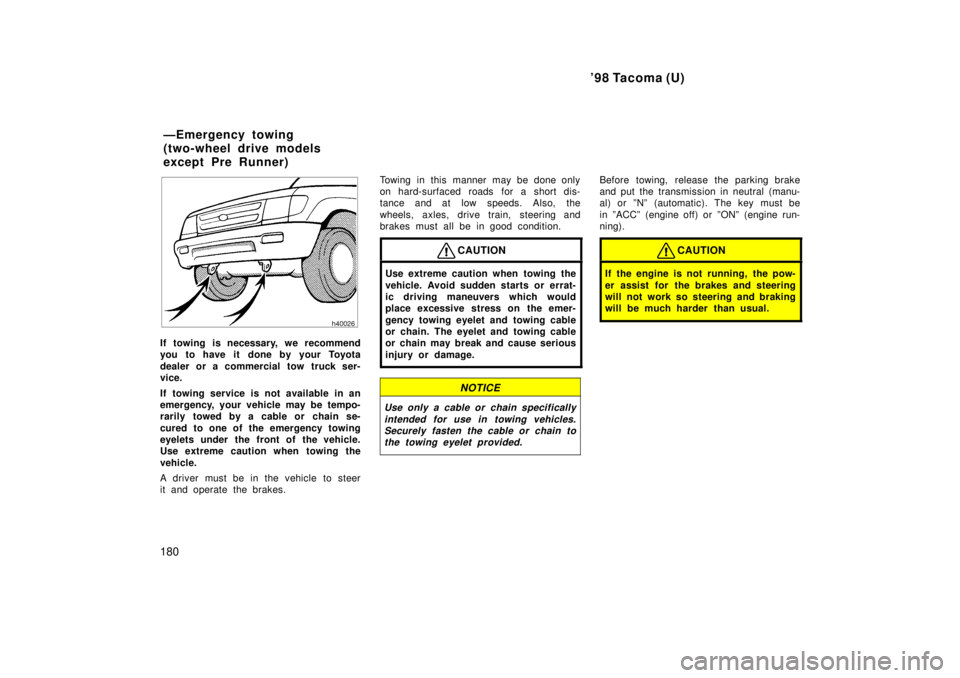1998 TOYOTA TACOMA ECU
[x] Cancel search: ECUPage 180 of 246

'98 Tacoma (U)
180
If towing is necessary, we recommend
you to have it done by your Toyota
dealer or a commercial tow truck ser-
vice.
If towing service is not available in an
emergency, your vehicle may be tempo-
rarily towed by a cable or chain se-
cured to one of the emergency towing
eyelets under the front of the vehicle.
Use extreme caution when towing the
vehicle.
A driver must be in the vehicle to steer
it and operate the brakes. Towing in this manner may be done only
on hard-surfaced roads for a short dis-
tance and at low speeds. Also, the
wheels, axles, drive train, steering and
brakes must all be in good condition.
CAUTION
Use extreme caution when towing the
vehicle. Avoid sudden starts or errat-
ic driving maneuvers which would
place excessive stress on the emer-
gency towing eyelet and towing cable
or chain. The eyelet and towing cable
or chain may break and cause serious
injury or damage.
NOTICE
Use only a cable or chain specificallyintended for use in towing vehicles.Securely fasten the cable or chain to the towing eyelet provided.
Before towing, release the parking brake
and put the transmission in neutral (manu-
al) or ºNº (automatic). The key must be
in ºACCº (engine off) or ºONº (engine run-
ning).
CAUTION
If the engine is not running, the pow-
er assist for the brakes and steering
will not work so steering and braking
will be much harder than usual.
ÐEmergency towing
(two-wheel drive models
except Pre R unner)
Page 181 of 246

'98 Tacoma (U)181
If towing is necessary, we recommend
you to have it done by your Toyota
dealer or a commercial tow truck ser-
vice.
If towing service is not available in an
emergency, your vehicle may be tempo-
rarily towed by a cable or chain se-
cured to the emergency towing hook
under the front of the vehicle. Use ex-
treme caution when towing the vehicle.
A driver must be in the vehicle to steer
it and operate the brakes. Towing in this manner may be done only
on hard-surfaced roads for a short dis-
tance and at low speeds. Also, the
wheels, axles, drive train, steering and
brakes must all be in good condition.
CAUTION
Use extreme caution when towing the
vehicle. Avoid sudden starts or errat-
ic driving maneuvers which would
place excessive stress on the emer-
gency towing hook and towing cable
or chain. The hook and towing cable
or chain may break and cause serious
injury or damage.
NOTICE
Use only a cable or chain specificallyintended for use in towing vehicles.Securely fasten the cable or chain to the towing hook provided.
Before towing, release the parking brake,
put the transmission in neutral (manual) or
ºNº (automatic) and set the transfer in
ºH2º mode. The key must be in ºACCº
(engine off) or ºONº (engine running).
CAUTION
If the engine is not running, the pow-
er assist for the brakes and steering
will not work so steering and braking
will be much harder than usual.
ÐEmergency towing
(four-wheel drive models and
Pre Runner)
Page 194 of 246

'98 Tacoma (U)
194
Tire surface and wheel nuts
Check the tires carefully for cuts, damage
or excessive wear. See Chapter 7- 2 for
additional information. When checking the
tires, make sure no nuts are missing, and
check the nuts for looseness. Tighten
them if necessary.
Tire rotation
Rotate the tires every 12000 km (7500
miles). See Chapter 7- 2 for additional in-
formation.
Fluid leaks
Check underneath for leaking fuel, oil, wa-
ter or other fluid after the vehicle has
been parked for a while. If you smell fuel
fumes or notice any leak, have the cause
found and corrected immediately.
Doors and engine hood
Check that all doors including tailgate op-
erate smoothly and all latches lock se-
curely. Make sure the engine hood sec-
ondary latch secures the hood from
opening when the primary latch is re-
leased.
INSIDE THE VEHICLE
Items listed below should be checked
regularly, e.g. while performing periodic
services, cleaning the vehicle, etc.
Lights
Make sure the headlights, stop lights, tail
lights, turn signal lights, and other lights
are all working. Check headlight aim.
Service reminder indicators and warning
buzzers
Check that all service reminder indicators
and warning buzzers function properly.
Steering wheel
Be alert for changes in steering condition,
such as hard steering or strange noise.
Seats
Check that all seat controls such as seat
adjusters, seatback recliner, etc. operate
smoothly and that all latches lock securely
in any position. Check that the head re-
straints move up and down smoothly and
that the locks hold securely in any latched
position. For folding-down seatback (bench
seat), check that the latches lock secure-
ly.Seat belts
Check that the seat belt system such as
buckles, retractors and anchors operate
properly and smoothly. Make sure the belt
webbing is not cut, frayed, worn or dam-aged.
Accelerator pedal
Check the pedal for smooth operation and
uneven pedal effort or catching.
Clutch pedal
Check the pedal for smooth operation.
Brake pedal
Check the pedal for smooth operation and
that the pedal has the proper clearance.
Check the brake booster function.
Brakes
At a safe place, check that the brakes do
not pull to one side when applied.
Parking brake
Check that the lever has the proper travel
and that, on a safe incline, your vehicle
is held securely with only the parking
brake applied.
Page 195 of 246

'98 Tacoma (U)195
Automatic transmission ºPark'' mecha-
nism
Check the lock release button of the se-
lector lever (floor shift type) for proper
and smooth operation. On a safe incline,
check that your vehicle is held securely
with the selector lever in ºP'' position and
all brakes released.
IN THE ENGINE COMPARTMENT
Items listed below should be checked
from time to time, e.g. each time when
refueling.
Washer fluid
Make sure there is sufficient fluid in the
tank. See Chapter 7- 3 for additional in-
formation.
Engine coolant level
Make sure the coolant level is between
the ºFULL'' and ºLOW'' lines on the see-
through reservoir when the engine is cold.
See Chapter 7- 2 for additional information.
Battery electrolyte level
Make sure the electrolyte level of all bat-
tery cells is between upper and lower lev-
el lines on the case. Add only distilled
water when replenishing. See Chapter 7- 3
for additional information.
Brake fluid level
Make sure the brake fluid level is correct.
See Chapter 7- 2 for additional information.
Engine oil level
Check the level on the dipstick with the
engine turned off and the vehicle parked
on a level spot. See Chapter 7- 2 for addi-
tional information.
Power steering fluid level
Check the level on the dipstick. The level
should be in the ºHOT'' or ºCOLD'' range
depending on the fluid temperature. See
Chapter 7- 2 for additional information.
Exhaust system
If you notice any change in the sound of
the exhaust or smell exhaust fumes, have
the cause located and corrected immedi-
ately. (See engine exhaust cautions in
Part 2.)
Be on the alert for changes in perfor-
mance, sounds, and visual tip-offs that
indicate service is needed. Some impor-
tant clues are as follows:
� Engine missing, stumbling, or pinging
� Appreciable loss of power
� Strange engine noises
� A leak under the vehicle (however, wa-
ter dripping from the air conditioning
after use is normal.)
� Change in exhaust sound (This may
indicate a dangerous carbon monoxide
leak. Drive with the windows open and
have the exhaust system checked im-
mediately.)
� Flat-looking tire; excessive tire squeal
when cornering; uneven tire wear
� Vehicle pulls to one side when driving
straight on a level road
� Strange noises related to suspension
movement
� Loss of brake effectiveness; spongy
feeling brake or clutch pedal; pedal al-
most touches floor; vehicle pulls to one
side when braking
� Engine coolant temperature continually
higher than normal
Does your vehicle need
repairing?
Page 233 of 246

'98 Tacoma (U)233
Engine compartment (Canada)
6. HEAD (LO LH) 10 A: Left-hand head-
light (low beam)
7. TAIL 10 A: Tail lights, licence plate
lights
8. PANEL 10 A: Emergency flashers,
heater control system, air conditioning
system, g auges and meters, clock, car
audio system, overdrive indicator light,
glovebox light, cigarette lighter, instru-
ment panel lights, rear differential lock
system, Multiport fuel injection system/
sequential multiport fuel injection sys-
tem, electronically controlled automatic
transmission system
9. A.C 10 A: Air conditioning systemInstrument panel
10. STOP 15 A: Stop lights, high-mounted
stoplight, cruise control system
11. ALT-S 7.5 A: Charging system
12. DOME 15 A: Car audio system, power
antenna, interior light, clock, ignition
switch light, personal lights, door cour-
tesy lights
13. OBD 10 A: On-board diagnosis system
14. HORN 15 A: Emergency flashers,
horns
15. EFI 15 A: Multiport fuel injection sys-
tem/sequential multiport fuel injection
system
16. HEAD (RH) 10 A: Right-hand headlight17. HEAD (LH) 10 A:
Left-hand headlight
18. STA 7.5 A: Clutch start cancel system,
starting system, gauges and meters
19. 4WD 20 A: A.D.D. control system,
four-wheel drive control system, rear
differential lock system
20. GAUGE 10 A: Gauges and meters,
back-up lights, cruise control system,
power antenna, power door lock control
system, electronically controlled auto-
matic transmission system, starting
system, charging system, air c ondition-
ing system
21. TURN 10 A: Turn signal lights, emer-
gency flashers
22. ECU-IG 15 A: Cruise control system,
anti-lock brake system, automatic
transmission shift lock system
23. WIPER 20 A: Windshield wipers and
washer
24. IGN 7.5 A: Discharge warning light,
SRS airbag system, Multiport fuel injec-
tion system/sequential multiport fuel in-
jection system
25. RADIO 7.5 A: Car audio system, pow-
er antenna
Page 234 of 246

'98 Tacoma (U)
234
26. CIG 15 A:
Cigarette lighter, clock, pow-
er rear view mirrors, back-up lights,
automatic transmission shift lock sys-
tem
27. ECU-B 15 A: SRS airbag warning light,
daytime running light system, cruise
control system
Fuses (type B)
28. POWER 30 A: Power windows
29. AM1 40 A: Starting system
30. AM2 30 A: Ignition system
Fuses (type C)
31. ABS 60 A: Anti-lock brake system
32. HEATER 40 A: ºA.Cº fuse
33. ALT 80 A: ºABSº, ºAM1º, ºHEATERº,
ºA.Cº, ºTAILº, ºPANELº, ºSTOPº and
ºALT-Sº, ºPWR OUTLETº fuses
Page 239 of 246

'98 Tacoma (U)239
Four- wheel drive models
and Pre Runner
Normal cab models
With 2 or 3 occupants 499 kg (1100 lb.)
Xtra- cab models
Vehicles with off road package With 2 occupants 340 kg (750 lb.)
With 3 occupants 272 kg (600 lb.)
With 5 occupants
136 kg (300 lb.)
Vehicles without off road package With 2 or 3 occupants
499 kg (1100 lb.)
With 5 occupants 318 kg (700 lb.) When the truck is used to carry a slide- in
camper, the total cargo load of the truck
consists of the manufacturer 's camper
weight figure, the weight of installed addi-
tional camper equipment not included in
the manufacturer 's camper weight figure,
the weight of camper cargo, and the
weight of passengers in the camper.
The total cargo load should not exceed
the truck's cargo weight rating and the
camper 's center of gravity should fall with-
in the truck's recommended center of
gravity zone when installed.
CAUTION
Be carefulÐoverloading can cause
dangerous braking and handling prob-
lems, and can damage your vehicle
and its tires.
Gross axle weight rating
Front GAWR Rear GAWR
Secure loose items to prevent weight
shifts that could affect the balance of your
vehicle. When the truck camper is loaded,
drive to a scale and weigh on the front
and on the rear wheels separately to de-
termine axle loads. Individual axle loads
should not exceed either of the Gross
Axle Weight Ratings (GAWR). The total of
the axle loads should not exceed the
Gross Vehicle Weight Rating (GVWR). The
GAWR and GVWR are indicated on the
Certification Label. See ºYour Toyota's
identificationº in Part 2 for the Certification
Label location.
ÐGross axle and vehicle
weight ratings